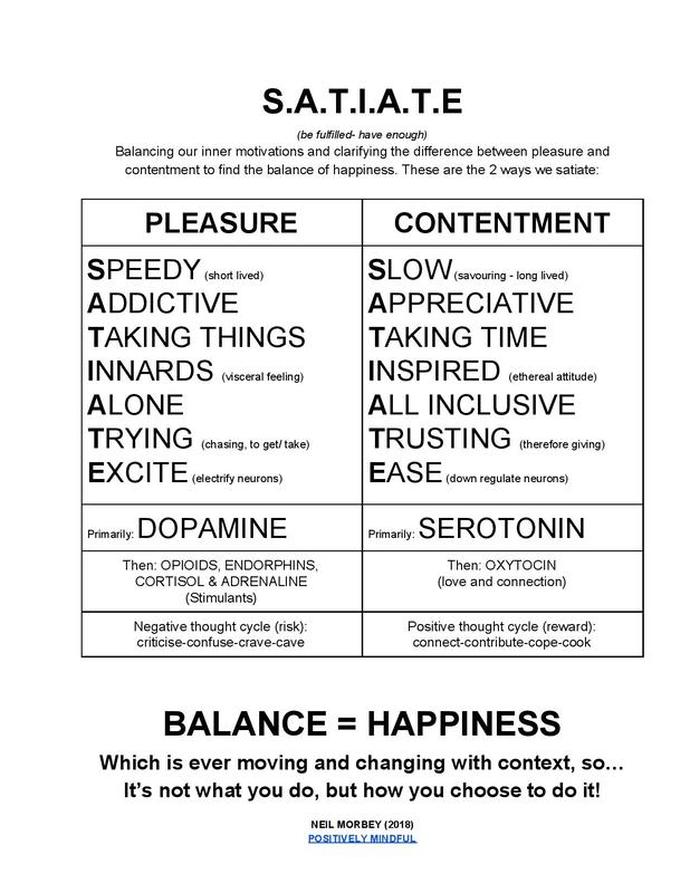|
This blog is a sharing of some of the information I teach at the start of a mindfulness course - I've knocked it up quite quickly. The theory is informed by the work of Robert Lustig a leading US academic who studies addiction and hedonic behaviour and explains brilliantly the difference between happiness and pleasure. I've supplemented his work with my own ideas. Enjoy! We've confused Happiness with Pleasure If I were to ask you the difference between happiness and pleasure I'm guessing you'd struggle. That's because modern capitalism has conflated the two. I'm here to suggest we can't' do', 'take', 'get' or 'buy happiness (which means we have to ignore the marketing and social lies), because it is a balance of two things - pleasure and contentment and contentment is something trickier to get hold of. Sure there is a little more to it (meaning for one) but by realising the balance we can start to understand why we might be unhappy, when we see we are chasing our tail, so to speak. If we choose to balance serotonin and dopamine in our system then we may be on a happier track. Let me explain... How do we find balance?
Let's start by looking at the two neurotransmitters that Robert points out... Dopamine: is the exciting neurotransmitter that excites neurons (as a signal to pay attention) in anticipation of a stimulant. Endogenous opioid (rush of pleasure), Cortisol (rush of fear/excitement), Adrenaline (rush of energy for attack) or Endorphins (rush of pain relief), after which the neurons must close down to protect themselves, which gives a feeling of withdrawal. This is all a natural part of our motivation system, like the dog - doing, getting, busy, like:
Modern Tricks: We can now trick our reward systems with these things, which we may want to consider reducing:
Serotonin: is the down-regulator of neurons, which is a necessary component in relating, resting and digesting (food and information). If dopamine is ‘doing’, serotonin is ‘Being’ - like the sloth - slow, calm, content. Or a Cat purring nicely. We can generate this via:
Risk / Reward Cycles: IT’S NOT WHAT YOU DO, SO MUCH AS HOW YOU DO IT. Any activity can be done in a content way (with rewards), or a way that chases pleasure (with risks). Doing something dog-like: to chase and control a pleasurable outcome risks falling into our innate bias towards negative thinking, which could negate our efforts to find pleasure. The mind may jump to negative stories as expectations are rarely met, creating confusion & craving. Some activities encourage contentment - meditation, reading, walking, whereas others discourage contentment, like gambling or gossip. The more we ‘choose how to be’ with mindfulness the more activities can be contented. Doing something cat-like, or sloth-like: mindfully, slowing down to to connect. This will lead us to more long-term rewards. Sex, sports, and productivity can all be a contented if we slow down and reduce our ‘need’ for pleasure and ‘avoidance’ of pain. Then we can balance our desires and find happiness in the mix. In order to summarise I made a fun table, enjoy! It's based on the 7 differences Robert discussed, and I've made an acronym!!!
3 Comments
Neil
22/10/2018 10:53:15 pm
Thank you! :)
Reply
24/3/2020 02:16:28 am
Happiness is how we find the balance? Really it was fantastic and making the essential thoughts and programs as well. Keep follow the site for interesting techniques on writing assignments with us.
Reply
Leave a Reply. |
AuthorsNeil Morbey is a meditation teacher, group facilitator and inspiration guide for Positively-Mindful.com Blog Index
Archives
May 2024
|

 RSS Feed
RSS Feed